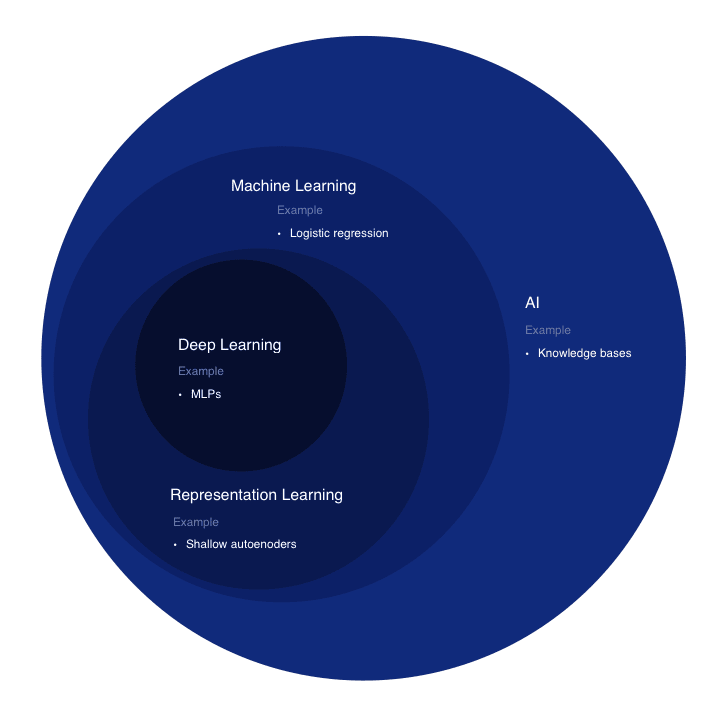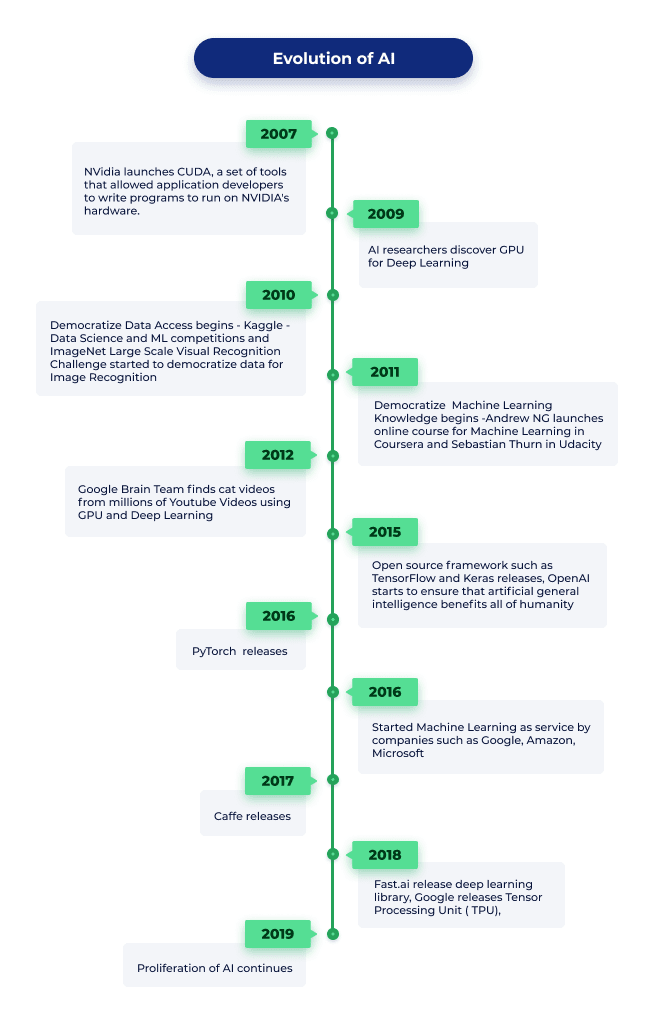Evolution of AI

lftechnology
Posted on August 20, 2019

In the past few years, AI evolved into a powerful tool that enables machines to think and act like humans. Moreover, it has garnered focus from tech companies around the world and is considered as the next significant technological shift after the evolution in mobile and cloud platforms. Some even call it the fourth industrial revolution. Forbes states, “By 2020, businesses that use AI and related technologies like machine learning and deep learning to uncover new business insights will take $1.2 trillion each year from competitors that don’t employ these technologies.”
This article gives you an overview of the evolution of AI and sets a foundational understanding of important milestones that led the path for AI surge.
Artificial Intelligence (AI)
According to the Merriam Webster dictionary, “Artificial intelligence is a branch of computer science dealing with the simulation of intelligent behavior in computers.” When a machine can make intelligent decisions, it can be referred to as being intelligent- artificially. We mostly see people using the terms of machine learning, deep learning, and AI synonymously. However, deep learning is a subset of machine learning, and machine learning is a subset of AI.
A Venn diagram showing how deep learning is a kind of representation learning, which is, in turn, a kind of machine learning, which is used for many but not all approaches to AI. Each section of the Venn diagram includes an example of AI.

A Venn diagram showing how deep learning is a kind of representation learning, which is, in turn, a kind of machine learning, which is used for many but not all approaches to AI. Each section of the Venn diagram includes an example of AI.
When did the AI surge begin?
Back in the 1800s, AI was limited in myths, fiction, and speculation. Classical philosophers envisioned machines integrated into human beings. However, they were just portrayed in fiction work like Mary Shelly’s “Frankenstein” then. The real initiation in AI began in 1956. The seed that led towards an AI future was a workshop in Darthmod College, attendees of which were claimed as AI leaders for decades to come.
The AI surge began with six major design goals as follows:
- Teach machines to reason in accordance to perform sophisticated mental tasks like playing chess, proving mathematical theorems, and others.
- Knowledge representation for machines to interact with the real world as humans do — machines needed to be able to identify objects, people, and languages. Programming language Lisp was developed for this very purpose.
- Teach machines to plan and navigate around the world we live in. With this, machines could autonomously move around by navigating themselves.
- Enable machines to process natural language so that they can understand language, conversations and the context of speech.
- Train machines to perceive the way humans do- touch, feel, sight, hearing, and taste.
- General Intelligence that included emotional intelligence, intuition, and creativity.
All these goals set the foundation to build a machine with human capabilities. Millions of dollars were invested in bringing their vision to life. However, soon, the US government realized the absence of powerful computing technologies needed to implement AI. The funds were withdrawn, and the journey took the first halt in the late 80s.
The need for a massive amount of data and enormous computing power disrupted the progress in the 80s. The 21st century, however, brought the concept quickly back to life proving Moore's law. The heavy processing power that tiny silicons hold today has made AI feasible in the current context, also enabling to build improved algorithms.
There have been four successive catalysts in the AI rebirth and revolution:
- The democratization of AI knowledge that began when world-class research contents were made available to the masses- starting with MOOCs from Stanford University with Andrew NG and Intro to ML by Sebastian Thurn and Katie Malone from Udacity.
- Data and Computing Power (cloud and GPU) that made AI accessible to the masses without enormous upfront investment or being a mega-corporation.
- Even with access to data and computing power, you had to be an AI specialist to leverage it. However, in 2015, there was a proliferation of new tools and frameworks that made exploring and operationalizing production-level AI feasible to the masses. You can now build on the backs of giants like Google (Tensorflow), and Facebook( PyTorch). Numerous organizations have been founded with the democratization of AI like FastAI and OpenAI.
- In the past two years, AI as a service has taken this a step further, enabling easier prototyping, exploration, and even building sophisticated and intelligent use-case specific AI's in the product. There are platforms like Azure AI, AWS AI, Google Cloud AI, IBM Cloud AI, and many more that provides AI as a Service.
Humankind has witnessed AI identifying cat videos to the invention of self-driving cars. More companies are trying to apply AI to solve problems and build an AI strategy in the organization. The journey of AI, which began with six goals, is gradually being achieved today. With further advancement in technology, a future with humans and machines living together seems possible. Now, we can either choose to observe the trend or start planning our AI strategy to create an impact in a world driven by technology.
Thank you for reading!
If you want to learn more about implementing AI into your Product

Posted on August 20, 2019
Join Our Newsletter. No Spam, Only the good stuff.
Sign up to receive the latest update from our blog.
Related

November 28, 2024

November 27, 2024



